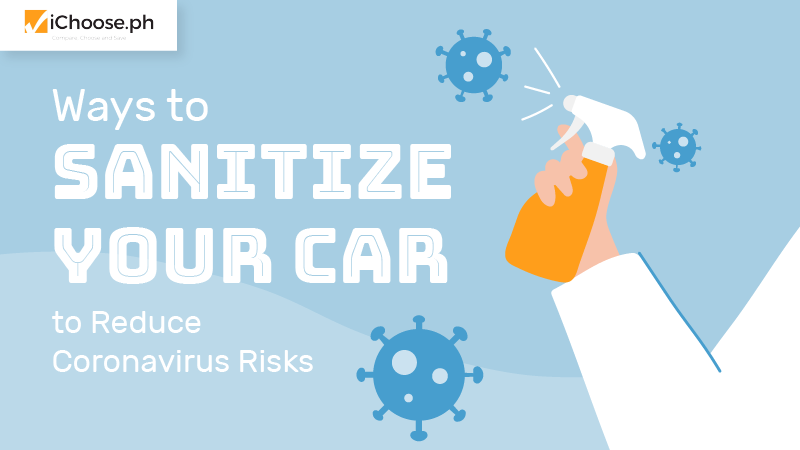Ways to Sanitize Your Car to Reduce Coronavirus Risks
It has been highlighted that staying home, avoiding social gatherings, following social distancing protocols, and frequently washing hands, including sanitizing car can help protect individuals from contracting the SARS-CoV-2 and, in the bigger picture, hamper the spread of COVID-19 and put an end to the health crisis.
Nonetheless, there is another thing you can add as part of your disease prevention strategies: sanitizing your vehicle. It is the first thing you touch or get into after leaving work or running an errand at a mall, supermarket, or other public places – hence, the first area where you may leave traces.
Sanitizing your vehicle means reducing germs, bacteria, and viruses in the cabin and lowering your infection risk.
How to Sanitizing Car
There are two ways to sanitize your car to reduce possible coronavirus infection: using sanitizer sprays and disinfectant wipes/gels products.
The most common way of sanitizing the vehicle is through the use of sanitizer sprays – it is a convenient and effective way of disinfecting a vehicle’s cabin, killing about 99.9% of microbes that can cause an infection.
Accordingly, disinfectant products specifically designed for interior and exterior upholstery of vehicles are available on the market. These disinfectants come in the form of wipes or gels and are excellent in getting rid of bacteria, germs, and viruses on frequently touched surfaces on the vehicle.
Things to Do Before Sanitizing Your Car
While sanitizing does the trick of reducing bacteria, germs, and viruses in your vehicle, cleaning the car before disinfecting can further lower the risk of infection. This comes as dirt, dust, and other debris inside your car can become a breeding ground for microbes. Accordingly, dirty air filters and ducts can recirculate germs and cause infections.
Prepare cleaning materials
Before cleaning and sanitizing your car, you must prepare cleaning equipment or materials such as vacuum, microfiber cloth, or any soft cleaning cloth.
You also have to prepare the cleaning solutions you will be using. It is crucial to read your car’s manual to know which products are recommended for use in your vehicle and which ones you should steer clear of. Generally, manufacturers advise owners not to use harsh chemicals and strong solutions such as bleach, ammonia-based products, hydrogen peroxide, acetone, and chlorine. Instead, use non-corrosive, pH-neutral soap, alcohol, or sanitizing/disinfecting solutions when cleaning vehicles.
Wear PPE
Accordingly, you also have to wear personal protective equipment (PPE) such as goggles, gloves, and masks before going through the actual cleaning and sanitizing of your vehicle. This can help you protect yourself from contracting the virus if an area of your car has been contaminated with bodily fluids from someone with confirmed or suspected coronavirus.
Remove Dust, Dirt, and Debris inside your vehicle
There are different methods on how you can get rid of dirt, dust, and other debris to prevent germs and bacteria from festering on them:
[1] Clear out unwanted items and trash in the cabin
[2] Remove and clean car mats and boot liner
[3] Vacuum the vehicle’s interior and carpets
[4] Clean the car’s air ducts and replace cabin air filters
Clean the Vehicle’s Upholstery
Viruses usually remain viable for a longer time on some surfaces. For example, SARS-CoV-2, the virus responsible for COVID-19 infection, can survive up to 72 hours (3 days) on non-porous surfaces like plastic, steel, and glass. Given that most of the main components of vehicles are made up of these non-porous materials, it makes sense to clean the entire vehicle upholstery.
Aggressive cleaning is not required when cleaning your vehicle’s upholstery. You can use car-safe soap and water or alcohol-based solution to clean some interior surfaces. Accordingly, you can use disinfectant solutions and sanitizing sprays to disinfect other frequently touched surfaces.
Here is a checklist of the frequently touched vehicle parts that need to be cleaned and sanitized:
Interior
- Knobs and buttons
- Touchscreen devices
- Cup holders
- Dashboard
- Door handles
- Gear shift
- Glove compartment
- Hand brake
- Ignition
- Key and remote-control fob
- Light switches
- Rearview mirror
- Seats
- Seat belts and buckles
- Steering wheel
- Turn indicator levers
Exterior
- Boot handle
- Door handles
- Fuel cap
Conclusion
Cleaning and sanitizing your vehicle can play a significant role in lowering your chances of contracting COVID-19 infection and protecting yourself and your family. And, it is recommended to do this at least once a week.
But apart from protecting yourself and your family against the virus, it is also within your duty to protect your vehicle – this means you have to conduct regular care and maintenance and purchase car insurance.
Acquiring CTPL insurance or comprehensive car insurance can help you ensure financial security in case of an unfortunate event, such as an accident or property damage involving your car. To select the best car insurance policy, you must shop around and compare insurance quotes from various insurance providers.
You can seamlessly get insurance quotes by utilizing car insurance comparison Philippines websites like iChoose PH. Visit our website at iChoose.ph to view unbiased quotations from some industry’s leading insurance companies.
Read More: Tips to Maintaining Your Car During COVID-19 Quarantine
More useful reads from iChoose.ph







